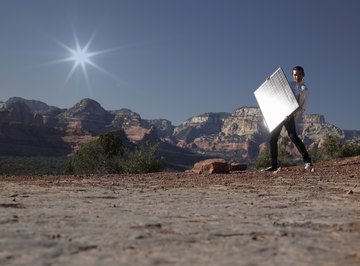
While you can travel using only camp sites with an electric power hook-up, adding a solar power electric system to your trailer greatly increases the number of places you can stop and still have electricity. To install solar power in your trailer, you have to determine how much power you have to generate and how much storage you need. You free yourself from using only serviced camp sites and don't have to put up with noisy generators.
Loads
You can save money by reducing your electric consumption to a minimum, since solar panels and batteries are expensive. Anything you can run at 12 volts of direct current adds efficiency because you don't have the losses of converting it to 120 volts alternating current. LED lights operating at 12 volts direct current are a highly efficient light source. Camping stores have other 12 volt direct current gear. You can get chargers operating on 12 volts direct current for electronic devices, but you may want to get a small inverter with a 120 volt alternating current output to run small loads that need household current.
Solar Panels
Look for load information on appliance nameplates and printed on light bulbs. Once you know what your loads will be, you can choose your solar panels. Multiply each load by the number of hours you use it in a typical day, and add the resulting watt-hours. A 50-watt solar panel might generate 200 to 300 watt-hours with four to six hours of direct sunlight per day. A 50- or 75-watt panel may be enough to start with, and you can get more panels if one proves to be too small.
Batteries
When it's dark or cloudy, your power has to come from batteries. Golf-cart batteries are large, deep-discharge batteries suitable for use in a travel trailer. Their rating, in ampere-hours, has to match your solar panels. A typical size is 100 ampere-hours, but you can only discharge them to about 50 percent because the voltage starts dropping. With 50 ampere-hours available, you have 50 times 12 volts of direct current equal to 600 watt-hours capacity. Such a battery could handle storage for up to two 50-watt solar panels if your use is about 600 watt-hours per day and your solar panels generate 300 watt-hours each day.
Additional Equipment
To operate your solar system effectively, you need charge controllers and meters. Charge controllers prevent the solar panels from overcharging the batteries and damaging them, as can happen when you get a lot of sun and don't use much power. A solar system monitor measures how many amps you are using and how many amps the solar cells are generating. A watt meter can give you the same information, but in watts used and generated. These meters let you estimate how much power you have left in your system, and whether you need to conserve power.
References
About the Author
Bert Markgraf is a freelance writer with a strong science and engineering background. He has written for scientific publications such as the HVDC Newsletter and the Energy and Automation Journal. Online he has written extensively on science-related topics in math, physics, chemistry and biology and has been published on sites such as Digital Landing and Reference.com He holds a Bachelor of Science degree from McGill University.
Photo Credits
Ryan McVay/Lifesize/Getty Images
